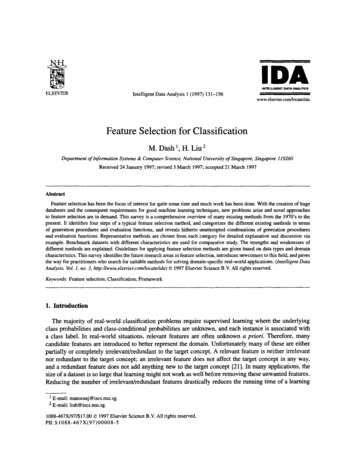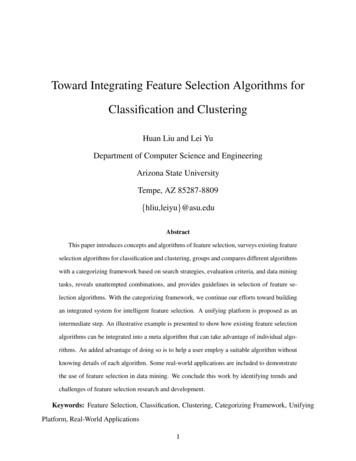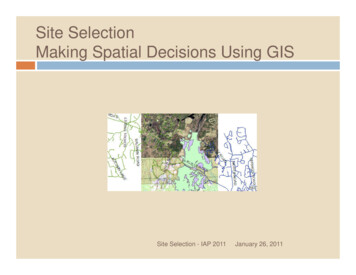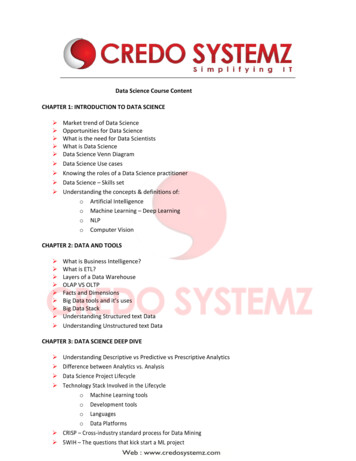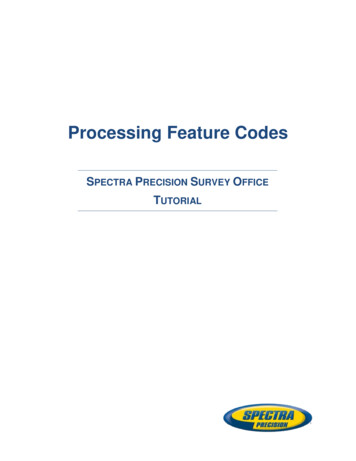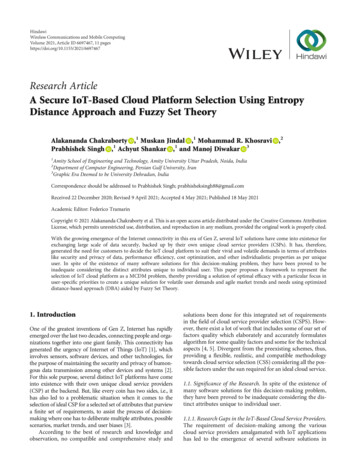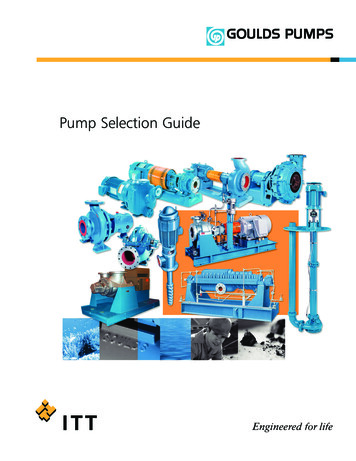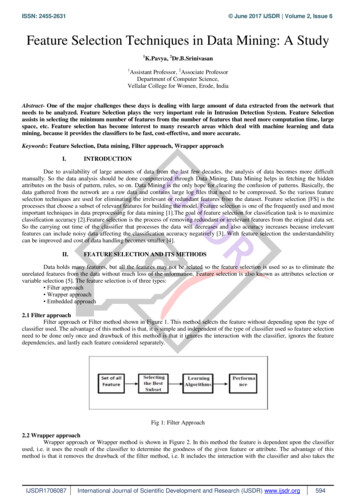
Transcription
ISSN: 2455-2631 June 2017 IJSDR Volume 2, Issue 6Feature Selection Techniques in Data Mining: A Study1K.Pavya, 2Dr.B.Srinivasan1Assistant Professor, 2Associate ProfessorDepartment of Computer Science,Vellalar College for Women, Erode, IndiaAbstract- One of the major challenges these days is dealing with large amount of data extracted from the network thatneeds to be analyzed. Feature Selection plays the very important role in Intrusion Detection System. Feature Selectionassists in selecting the minimum number of features from the number of features that need more computation time, largespace, etc. Feature selection has become interest to many research areas which deal with machine learning and datamining, because it provides the classifiers to be fast, cost-effective, and more accurate.Keywords: Feature Selection, Data mining, Filter approach, Wrapper approachI.INTRODUCTIONDue to availability of large amounts of data from the last few decades, the analysis of data becomes more difficultmanually. So the data analysis should be done computerized through Data Mining. Data Mining helps in fetching the hiddenattributes on the basis of pattern, rules, so on. Data Mining is the only hope for clearing the confusion of patterns. Basically, thedata gathered from the network are a raw data and contains large log files that need to be compressed. So the various featureselection techniques are used for eliminating the irrelevant or redundant features from the dataset. Feature selection [FS] is theprocesses that choose a subset of relevant features for building the model. Feature selection is one of the frequently used and mostimportant techniques in data preprocessing for data mining [1].The goal of feature selection for classification task is to maximizeclassification accuracy [2].Feature selection is the process of removing redundant or irrelevant features from the original data set.So the carrying out time of the classifier that processes the data will decreases and also accuracy increases because irrelevantfeatures can include noisy data affecting the classification accuracy negatively [3]. With feature selection the understandabilitycan be improved and cost of data handling becomes smaller [4].II.FEATURE SELECTION AND ITS METHODSData holds many features, but all the features may not be related so the feature selection is used so as to eliminate theunrelated features from the data without much loss of the information. Feature selection is also known as attributes selection orvariable selection [5]. The feature selection is of three types: Filter approach Wrapper approach Embedded approach2.1 Filter approachFilter approach or Filter method shown in Figure 1. This method selects the feature without depending upon the type ofclassifier used. The advantage of this method is that, it is simple and independent of the type of classifier used so feature selectionneed to be done only once and drawback of this method is that it ignores the interaction with the classifier, ignores the featuredependencies, and lastly each feature considered separately.Fig 1: Filter Approach2.2 Wrapper approachWrapper approach or Wrapper method is shown in Figure 2. In this method the feature is dependent upon the classifierused, i.e. it uses the result of the classifier to determine the goodness of the given feature or attribute. The advantage of thismethod is that it removes the drawback of the filter method, i.e. It includes the interaction with the classifier and also takes theIJSDR1706087International Journal of Scientific Development and Research (IJSDR) www.ijsdr.org594
ISSN: 2455-2631 June 2017 IJSDR Volume 2, Issue 6feature dependencies and drawback of this method is that it is slower than the filter method because it takes the dependenciesalso. The quality of the feature is directly measured by the performance of the classifier.Selecting the Best SubsetSet of allFeaturesGeneratea SubsetLearningAlgorithmPerformanceFig 2: Wrapper Approach2.3 Embedded approachThe embedded approach or embedded method is shown in Figure 3. It searches for an optimal subset of features that isbuilt into the classifier construction. The advantage of this method is that it is less computationally intensive than a wrapperapproach.Selecting the Best SubsetSet of allFeaturesGenerate aSubsetLearningAlgorithm PerformanceFig 3: Embedded ApproachThe accuracy of the classifier depends not only on the classification algorithm but also on the feature selection methodused. Selection of irrelevant and inappropriate features may confuse the classifier and lead to incorrect results. The solution to thisproblem is Feature Selection i.e. feature selection is necessary in order to improve efficiency and accuracy of classifier. Featureselection selects subset of features from original set of features by removing the irrelevant and redundant features from theoriginal dataset. It is also known as Attribute selection. Feature selection reduces the dimensionality of the dataset, increases thelearning accuracy and improves result comprehensibility. The two search algorithms ‗forward selection‘ and ‗backwardeliminations‘ are used to select and eliminate the appropriate feature. Feature selection is a three step process namely search,evaluate and stop.Feature selection methods are also classified as attribute evaluation algorithms and subset evaluation algorithms. In firstmethod, features are ranked individually and then a weight is assigned to each feature according to each feature‗s degree ofrelevance to the target feature. The second approach in contrast, selects feature subsets and then ranks them based on certainevaluation criteria. Attribute evaluation methods do not measure correlation between feature are hence likely to yield subsets withredundant features. Subset evaluation methods are more efficient in removing redundant features. Different types of featureselection algorithms have been proposed. The feature selection techniques are broadly categorized into three types: Filtermethods, Wrapper methods, and Embedded methods. Every feature selection algorithm uses any one of the three feature selectiontechniques.2.1 Filter methodsRanking techniques are used as principle criteria in Filter method. The variables are assigned a score using a suitableranking criterion and the variables having score below some threshold value are removed. These methods are computationallycheaper, avoids over fitting but Filter methods ignore dependencies between the features. Hence, the selected subset might not beoptimal and a redundant subset might be obtained. The basic filter feature selection algorithms are as follows:2.1.1 Chi-square testThe chi-squared filter method test checks the independence between two events. The two events X, Y are defined to beindependent if P(XY) P(X)P(Y) or equivalently P(X/Y) P(X) and P(Y/X) P(Y). More particularly in feature selection it isused to test whether the occurrence of a specific term and the occurrence of a specific class are independent. Thus the followingquantity for each terms are estimated and rank them by their score: In equation: (1) High scores on χ2 indicate that the nullhypothesis (H0) of independence should be eliminated and thus that the occurrence of the term and class are dependent.(1)IJSDR1706087International Journal of Scientific Development and Research (IJSDR) www.ijsdr.org595
ISSN: 2455-2631 June 2017 IJSDR Volume 2, Issue 62.1.2 Euclidean DistanceIn this feature selection technique, the correlation between features is calculated in terms of Euclidean distance. Ifsample feature say ‗a‘ contains ‗n‘, then these ‗n‘ number of features are compared with other ‗n-1‘ features by calculating thedistance between them using the following equation: (2) The distance between features remains unaffected even after addition ofnew features.𝒅(𝒂, 𝒃) 𝒊(𝒂𝒊 𝒃𝒊 )𝟐1/2(2)2.1.3 Correlation criteriaPearson correlation coefficient is simplest criteria and is defined by the following equation: (3) Where, xi is i th variable,Y is the output class, var() is the variance and cov() denotes covariance. The disadvantage is that correlation ranking can onlydetect linear dependencies between variable and target.𝑹(𝒊) 𝒄𝒐𝒗(𝒙𝒊 ,𝒀)(3)𝒗𝒂𝒓 𝒙𝒊 𝒗𝒂𝒓(𝒀)2.1.4 Information GainInformation gain tells us how important a given attribute of the feature vectors is. IG feature selection method selects theterms having the highest information gain scores. Information gain measures the amount of information in bits about the classprediction, if the only information available is the presence of a feature and the corresponding class distribution. Concretely, itmeasures the expected reduction in entropy (uncertainty associated with a random feature) defined as:𝑬𝒏𝒕𝒓𝒐𝒑𝒚 𝒏𝒊 𝟏 𝒑𝒊 𝒍𝒐𝒈𝟐 𝒑𝒊(4)Where ‗n‗ is the number of classes, and the Pi is the probability of S belongs to class ‗i‗. The gain of A and S is calculated as:𝒎𝑮𝒂𝒊𝒏 𝑨 𝑬𝒏𝒕𝒓𝒐𝒑𝒚 𝑺 𝐒𝐤𝒌 𝟏 𝐒 𝐄𝐧𝐭𝐫𝐨𝐩𝐲 𝐒𝐤(5)Where, Sk is the subset of S.2.1.5 Mutual InformationInformation theoretic ranking criteria [ ] uses the measure of dependency between two variables. To describe MI wemust start with Shannon‗s definition for entropy given as:𝐇 𝐗 𝒊𝐏𝐲 𝐥𝐨𝐠 𝐏 𝐲(6)Above equation represents the uncertainty (information content) in output Y. Suppose we observe a variable X then theconditional entropy is given by:𝑯(𝒀 𝑿) 𝜮𝒊𝒚𝑷𝒙, 𝒚 𝒍𝒐𝒈 𝑷(𝒚 𝒙)(7)Above equation implies that by observing a variable X, the uncertainty in the output Y is reduced. The decrease in uncertainty isgiven as:I(Y, X) H(Y) - H(Y X)(8)This gives the MI between Y and X meaning that if X and Y are independent then MI will be zero and greater than zero if theyare dependent. This implies that one variable can provide information about the other thus proving dependency. The definitionsprovided above are given for discrete variables and the same can be obtained for continuous variables by replacing thesummations with integrations.2.1.6 Correlation based Feature Selection (CFS)Correlation-based Feature Selection algorithm selects attributes by using a heuristic which measures the usefulness ofindividual features for predicting the class label along with the level of inter-correlation among them. The highly correlated andirrelevant features are avoided. The equation used to filter out the irrelevant, redundant feature which leads the poor prediction ofthe class is defined as:𝑭𝒔 𝑵 𝒓𝒂𝑵 𝑵(𝑵 𝟏)𝒓𝒏(9)2.1.7 Fast Correlation based Feature SelectionFCBF (Fast Correlation Based Filter) [4] is a multivariate feature selection method which starts with full set of features,uses symmetrical uncertainty to calculate dependences of features and finds finest subset using backward selection technique withsequential search strategy. The FCBF algorithm consists of two stages: the first one is a relevance analysis that orders the inputvariables depending on a relevance score, which is computed as the symmetric uncertainty with respect to the target output. Thisstage is also used to discard irrelevant variables, whose ranking score is below a predefined threshold. The second stage is aIJSDR1706087International Journal of Scientific Development and Research (IJSDR) www.ijsdr.org596
ISSN: 2455-2631 June 2017 IJSDR Volume 2, Issue 6redundancy analysis, which selects predominant features from the relevant set obtained in the first stage. This selection is aniterative process that removes those variables which form an approximate Markov blanket. Symmetrical Uncertainty (SU) is anormalized information theoretic measure which uses entropy and conditional entropy values to calculate dependencies offeatures. In Symmetrical Uncertainty the value 0 indicates that two features are totally independent and value of 1 indicates thatusing one feature other feature's value can be totally predicted.2.2 Wrapper methodsWrapper methods are better in defining optimal features rather than simply relevant features. They do this by usingheuristics of the learning algorithm and the training set. Backward elimination is used by the wrapper method to remove theinsignificant features from the subset. The SVM-RFE is one of the feature selection algorithms which use the Wrapper method.The Wrapper method needs some predefined learning algorithm to identify the relevant feature. It has interaction withclassification algorithm. The over fitting of feature is avoided using the cross validation. Though wrapper methods arecomputationally expensive and take more time compared to the filter method, they give more accurate results than filter model. Infilter model, optimal features can be obtained rather than simply relevant features. Another advantage is it maintains dependenciesbetween features and feature subsets. Wrapper methods are broadly classified as sequential selection algorithms and heuristicsearch algorithms as follows:2.2.1 Sequential Selection AlgorithmsThe Sequential Feature Selection (SFS) [7][8][9] algorithm starts with an empty set and adds one feature for the first stepwhich gives the highest value for the objective function. After the first step, the remaining features are added individually to thecurrent subset and the new subset is evaluated. The individual features that give maximum classification accuracy arepermanently included in the subset. The process is repeated until we get required number of features. This algorithm is called anaive SFS algorithm since the dependency between the features is not taken into consideration.A Sequential Backward Selection (SBS)[10][11] algorithm is exactly reverse of SFS algorithm. Initially, the algorithmstarts from the entire set of variables and removes one irrelevant feature at a time whose removal gives the lowest decrease inpredictor performance. The Sequential Floating Forward Selection (SFFS) algorithm is more flexible than the naive SFS becauseit introduces an additional backtracking step. The algorithm starts same as the SFS algorithm which adds one feature at a timebased on the objective function. SFFS algorithm then applies one step of SBS algorithm which excludes one feature at a timefrom the subset obtained in the first step and evaluates the new subsets. If excluding a feature increases the value of the objectivefunction then that feature is removed and algorithm switches back to the first step with the new reduced subset or else thealgorithm is repeated from the top. The entire process is repeated until the required numbers of features are obtained or requiredperformance is reached. SFS and SFFS produce nested subsets since forward inclusion was unconditional.2.2.2 Heuristic Search AlgorithmsHeuristic search algorithms include Genetic algorithms (GA)[12], Ant Colony Optimization(ACO)[13], Particle SwarmOptimization(PSO)[14],etc. A genetic algorithm is a search technique used in computing to find true or approximate solution tooptimization and search problems. Genetic algorithms are based on the Darwinian principle of survival of the fittest theory. ACOis based on the shortest paths found by real ants in their search for food sources. ACO approaches suffer from inadequate rules ofpheromone update and heuristic information. They do not consider random phenomenon of ants during subset formations. PSOapproach does not employ crossover and mutation operators, hence is efficient over GA but requires several mathematicaloperators. Such mathematical operations require various user-specified parameters and dealing with these parameters, decidingtheir optimal values might be difficult for users. Although these ACO and PSO algorithms execute almost identically to GA, GAhas received much attention due to its simplicity and powerful search capability upon the exponential search spaces.2.3 Embedded methodsIn embedded method [15], a feature selection method is incorporated into a learning algorithm and optimized for it. It isalso called the hybrid model which is combination of filter and wrapper method. Embedded methods [16] reduce the computationtime taken up for reclassifying different subsets which is done in wrapper methods. The KP-SVM is the example for embeddedmethod. The problem of nesting effect of SFS and SFFS was overcome by developing an adaptive version of SFFS calledAdaptive Sequential Forward floating Selection (ASFFS) algorithm. In ASFFS algorithm, two parameters ‗r‗ and ‗o‗ are usedwhere ‗r‗ specifies number of features to be added while parameter ‗o‗ specifies number of features to be excluded from the set soas to obtain less redundant subset than the SFFS algorithm. The Plus L is a generalization of SFS and the Minus R is thegeneralization of SBE algorithm. If L R then the algorithm start with SFS algorithm i.e. start from empty set and add thenecessary features to the resultant set, else the algorithm start with the SBE algorithm i.e. start from entire set and starteliminating the irrelevant features and produce the resultant set. The Plus-L-Minus-r search method also tries to avoid nesting. Inthis method, the parameters L and r have to be chosen arbitrarily. It consumes less time than wrapper method but gives lessaccurate results than wrapper model as some of the important features may be lost by the filter model.III. NEED FOR FEATURE SELECTIONReduces the size of the problem.Reduce the requirement of computer storage.Reduce the computation time.Reduction in features to improve the quality of prediction.To improve the classifier by removing the irrelevant features and noise.IJSDR1706087International Journal of Scientific Development and Research (IJSDR) www.ijsdr.org597
ISSN: 2455-2631 June 2017 IJSDR Volume 2, Issue 6To identify the relevant features for any specific problem.To improve the performance of learning algorithm.IV.CONCLUSIONFeature selection is an important issue in classification, because it may have a considerable effect on accuracy of theclassifier. It reduces the number of dimensions of the dataset, so the processor and memory usage reduce; the data becomes morecomprehensible and easier to study on. In this study, various feature selection techniques have been discussed and among thethree approaches to feature selection method, filter methods should be used to get results in lesser time and for large datasets. Ifthe results to be accurate and optimal, wrapper method like GA should be used.REFERENCES[1] Asha Gowda Karegowda, M.A.Jayaram and A.S. Manjunath, ―Feature Subset Selection Problem using Wrapper Approach inSupervised Learning‖, International Journal of Computer Applications, Vol. 1, No. 7, pp. 0975–8887, 2010.[2] Ron Kohavi, George H. John, ―Wrappers for feature subset Selection‖, Artificial Intelligence, Vol. 97, No. 1-2. pp. 273-324,1997.[3] S. Doraisami, S. Golzari, A Study on Feature Selection and Classification Techniques for Automatic Genre Classification ofTraditional Malay Music, Content-Based Retrieval, Categorization and Similarity, 2008[4] A. Arauzo-Azofra, J. L. Aznarte, and J. M. Benítez, Empirical study of feature selection methods based on individual featureevaluation for classification problems, Expert Systems with Applications, 38 (2011) 8170-8177.[5] Beniwal, S., & Arora, J. (2012). Classification and feature selection techniques in data mining. International Journal ofEngineering Research & Technology (IJERT), 1(6).[6] Uysal, A. K., & Gunal, S., ―A novel probabilistic feature selection method for text classification,‖ Knowledge-BasedSystems, 36, 226–235, 2012.[7] S. Guan, J. Liu, Y. Qi, ―An incremental approach to contribution-based feature selection,‖ Journal of Intelligence Systems13 (1), 2004.[8] M.M. Kabir, M.M. Islam, K. Murase, ―A new wrapper feature selection approach using neural network,‖ in: Proceedings ofthe Joint Fourth International Conference on Soft Computing and Intelligent Systems and Ninth International Symposium onAdvanced Intelligent Systems (SCIS&ISIS2008), Japan, pp. 1953–1958, 2008.[9] M.M. Kabir, M.M. Islam, K. Murase, ―A new wrapper feature selection approach using neural network,‖ Neurocomputing73, 3273–3283, May 2010.[10] E. Gasca, J. Sanchez, R. Alonso, ―Eliminating redundancy and irrelevance using a new MLP-based feature selectionmethod,‖ Pattern Recognition 39, 313–315, 2006.[11] C. Hsu, H. Huang, D. Schuschel, ―The ANNIGMA-wrapper approach to fast feature selection for neural nets,‖ IEEETransaction son Systems, Man, and Cybernetics—Part B:Cybernetics32(2)207–212, April 2002.[12] A. Ghareb , A. Bakar, A. Hamdan, ―Hybrid feature selection based on enhanced genetic algorithm for text categorization,‖Expert SystemsWith Applications, Elsevier, 2015.[13] R.K. Sivagaminathan, S. Ramakrishnan, ―A hybrid approach for feature subset selection using neural networks and antcolony optimization,‖ Expert Systems with Applications 33, 49–60, 2007.[14] X. Wang, J. Yang, X. Teng, W. Xia, R. Jensen, ―Feature selection based on rough sets and particle swarm optimization,‖Pattern Recognition Letters 28 (4), 459–471, November 2006.[15] M.M. Kabir, M.M. Islam, K. Murase, ―A new local search based hybrid genetic algorithm for feature selection,‖Neurocomputing 74, 2194-2928, May 2011.[16] M. Zhu, J. Song, ―An Embedded Backward Feature Selection Method for MCLP Classification Algorithm,‖ InformationTechnology and Quantitative Management, Elsevier, 2013.IJSDR1706087International Journal of Scientific Development and Research (IJSDR) www.ijsdr.org598
Data Mining is the only hope for clearing the confusion of patterns. Basically, the data gathered from the network are a raw data and contains large log files that need to be compressed. So the various feature selection techniques are used for eliminating the irrelevant or redundant features from the dataset. Feature selection [FS] is the

